Today we’re talking about food. In my post Ten Minutes to Go! the food in the bug out bag was chosen as I dashed around my kitchen hooking out what I thought would be the most calorific. Now it’s time to see if I could have made better choices, both with what I had in the cupboards and what I could purchase in readiness for an emergency.
What are the key considerations?
- Weight – A key consideration for your back and important for every item in the bag.
- Dimension / Volume – The smaller the better so we don’t take up more space than is needed.
- Calorie Content Per Weight – The more calories in the same weight of food means we’re making more efficient use of the weight we’re carrying. Kcal per 100 grams is the measure used here in the UK. Even if you use different units in your country, the analysis is still as relevant.
- Shelf Life – When we need to eat the food it will last a few days, but it will be sitting inside the bag for years, hopefully never to be used, so we don’t want to keep replacing it, or forget and then be of no use when we come to need them.
- Availability – Would you normally have the food in your cupboards at home or is it something you would have to buy?
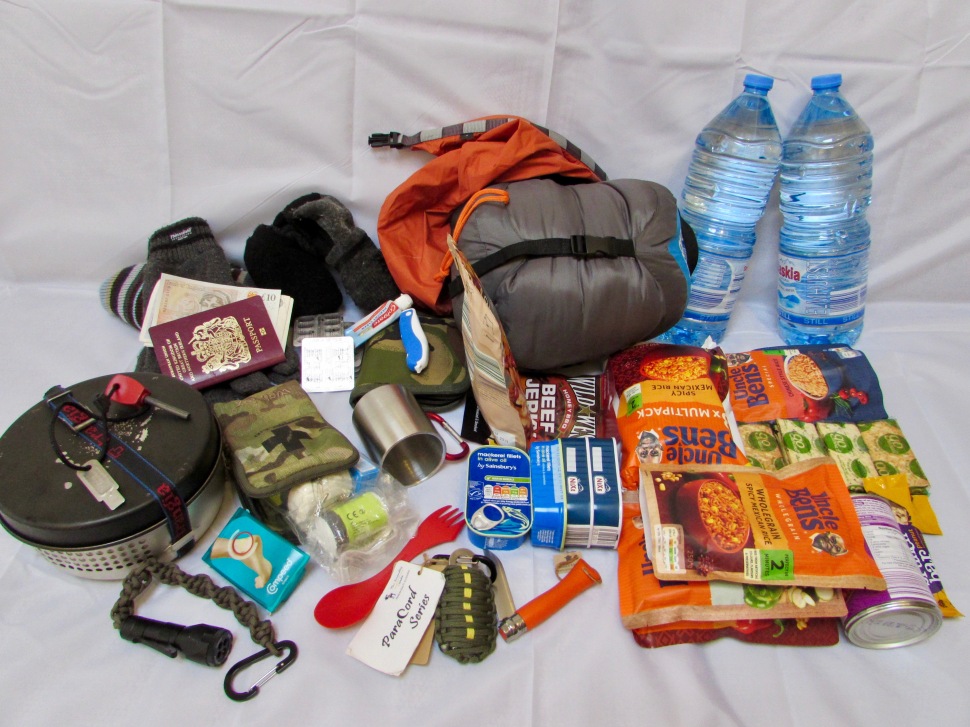
What’s Already in the Bag?
- Low Fast Biscuits x 6 – 260 grams – 1,000 kcals – Six months shelf life
- Packet Cooked Rice x 6 – 1,500 grams – 2,400 kcals – Nine months shelf life
- Tinned Fish x 4 – 560 grams – 1,400 kcals – Three years shelf life
- Tinned Beans & Sausages – 1 can – 476 grams – 475 kcals – Two years shelf life
- Beef Jerky – 1 packet – 35 grams – 100 kcals – Two years shelf life
The Analysis
With a total weight of just under 3kg, less than three percent of which is packaging, we’re getting 5,400 kcals. That’s just over the recommended energy intake for a man for two days. There’s a decent range of flavours in there, but the ingredients will start to go out of date within six months.
So can we do better with a little research?
Based on the key drivers we’ve already identified, I’ve picked out a list of contenders, some of which we’ve already got in the bag. Like with my previous posts we’ll give them marks for each area out of 5, with 5 being the highest score.
Here’s what we’ll look at.

- Calories per 100g – This factor tells us how efficient the food is at delivering calories, no matter how much weight we decide to carry.
- Packaging Weight – If you can’t find a really good use for the packaging after you’ve eaten the food then you’re wasting your energy carrying it on your back.
- Dimension / Volume – Space is as important as weight.
- Shelf Life – Hopefully you’re not going to need the pack, but when you do you want what’s in to be good to use and not have to update the contents every few months.
- Fragility – Can it handle being packed in the bag? Can it handle what you might have to go through with it on your back?
In the results we’ll also look at whether these items would normally be in your store cupboard.
There are other key areas we could also consider, like nutritional diversity. This is what else you’re getting apart from the raw energy. How much protein, fats, vitamins etc, but for the purpose of this post, we’re only looking at carrying enough food to last a few days. Once it’s used you’re going to have to find another source. I sense a new post idea on its way!
Tinned Fish
With so many varieties, each cooked in a multitude of sauces, you’ve got a lot to choose from.
- Calories per 100g – 280 kcals – 3/5
- Packaging Weight – 12% of the weight is the tin – 3/5
- Dimension / Volume – Pretty compact – 4/5
- Shelf Life – 3 years – 4/5
- Fragility – In a tin, will take a lot of punishment – 5/5
- Store Cupboard Item – Yes
Score = 19 / 25
Tinned Beans & Sausages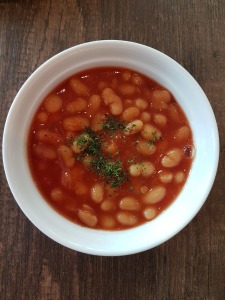
It’s an every day staple. What’s not to like?
- Calories per 100g – 113 kcals – 1/5
- Packaging Weight – 12% of the weight is the tin – 3/5
- Dimension / Volume – It’s a round, awkward tin – 3/5
- Shelf Life – 2 years – 3/5
- Fragility – In a tin, will take a lot of punishment – 5/5
- Store Cupboard Item – Yes
Score = 15 / 25
Packet Rice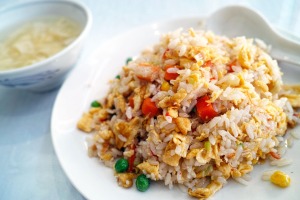
A colourful, spicy range of good tasting food.
- Calories per 100g – 153 kcals – 2/5
- Packaging Weight – Minimal – 5/5
- Dimension / Volume – Squishes down and fills any hole you put it into – 4/5
- Shelf Life – 9 months – 2/5
- Fragility – In a flexible packet it should take a fair battering – 5/5
- Store Cupboard Item – Yes
Score = 18 / 25
Low Fat Biscuits
Diet food is not the kind of thing I should have grabbed, but let’s see how it compares.
- Calories per 100g – 380 kcals – 4/5
- Packaging Weight – Minimal – 5/5
- Dimension / Volume – Huge volume, very low density – 1/5
- Shelf Life – 6 months – 1/5
- Fragility – Drop your bag once or twice and you’ll be hoovering up crumbs – 1/5
- Store Cupboard Item – Yes
Score = 12 / 25
Tinned Meat
Spam. So good they wrote a sketch about it. Okay, maybe they didn’t write the sketch because it was so great. It should do well here though.
- Calories per 100g – 292 kcals – 4/5
- Packaging Weight – 12% of the weight is the tin – 3/5
- Dimension / Volume – It’s a rectangular, awkward tin – 4/5
- Shelf Life – 3 years – 4/5
- Fragility – In a tin, will take a lot of punishment – 5/5
- Store Cupboard Item – Not in mine , but it may be in some people’s
Score = 20 / 25
Survival Biscuits
Seven Oceans Standard Emergency Ration
Provides enough nutrition to last one person 72 hours in a survival situation and gives the highest possible ratio of balanced nutrition packed in nine separate bars with grease-proof paper. The biscuit ration requires no preparation and may be eaten directly from the box. This unit is protected by a water-repellent cardboard box and are issued to most life rafts worldwide.
- Calories per 100g – 500 kcals – 5/5
- Packaging Weight – Minimal – 5/5
- Dimension / Volume – It’s the highest density of calories possible – 5/5
- Shelf Life – 5 years – 5/5
- Fragility – Dense blocks protected from water, these will take a fair bit of punishment – 4/5
- Store Cupboard Item – No
Score = 24 / 25
Chocolate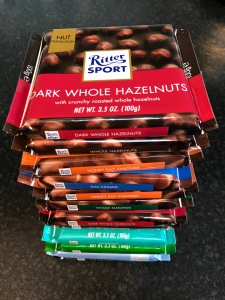
It gets my vote even before we take a proper look. Let’s hope it gets the numbers and we’re packing toothpaste!
- Calories per 100g – 534 kcals – 5/5
- Packaging Weight – Minimal – 5/5
- Dimension / Volume – Dense – 5/5
- Shelf Life – The packaging shows around a year, but that’s to keep it at its optimum quality. We’ll get 3 years out of it easily before we have to eat it and replace, especially those without extra ingredients such as nuts – 4/5
- Fragility – Water resistant packaging and product, it can get crumbled and it’ll still taste great, but get it too hot and you won’t be thankful – 4/5
- Store Cupboard Item – Yes
Score = 23 / 25
Romney’s Kendle Mint Cake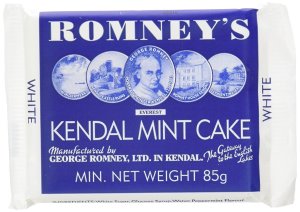
Traditional survival fare, and it’s a sweet hit. Not as nice as chocolate to eat, but does the same damage to your teeth. Let’s see how it compares.
- Calories per 100g – 320 kcals – 4/5
- Packaging Weight – Minimal – 5/5
- Dimension / Volume – Pretty compact – 4/5
- Shelf Life – It’s flavoured sugar and will easily outlast anything else on this page – 5/5
- Fragility – Less susceptible to heat than the chocolate but it’s going to crumble pretty easily – 3/5
- Store Cupboard Item – No
Score = 21 / 25
MRE Ration Packs
Meal Ready To Eat. These are military grade rations with each meal providing enough calories to keep a fighting force on its feet.
- Calories per 100g – 150 kcals – 2/5
- Packaging Weight – Small amount of packaging – 4/5
- Dimension / Volume – They come in a big box meant to be moved around in lorries with the troops as the battle line is forced forward. Taking them from their packaging will make it easier to store, but will reduce the protection – 3/5
- Shelf Life – 5 years – 5/5
- Fragility – We’ve got to take it from the packaging – 4/5
- Store Cupboard Item – No
Score = 18 / 25
Energy Bars
With so many varieties, all ready to eat from the packet, but are they the right thing to be carrying?
- Calories per 100g – 280 kcals – 3/5
- Packaging Weight – Minimal – 5/5
- Dimension / Volume – Like the diet biscuits, you’re going to need a lot of them – 1/5
- Shelf Life – 1 year – 2/5
- Fragility – Has no protection from what could happen out there – 1/5
- Store Cupboard Item – No
Score = 12 / 25
Preserved Meats
There are lots of different types of preserved meats, each packing a decent punch of calories. There’s continental cured and fermented meats, with most requiring no preparation to eat, then there’s hard dried meats such as jerky or biltong which will last the longest and are very dense in calories. The last major type is the hard packed brined meats. This preservation process involves packing it in salt to dry it out and the result can last several years. However it requires soaking in water for a little while to pull out the salt and make it edible. Not an option for survival.
For this comparison we’ll look at the readily available cured, fermented and air dried meats like Salami or Chorizo, both of which have the same key characteristics we’re interested in.
- Calories per 100g – 330 kcals – 4/5
- Packaging Weight – You can eat pretty much all of it apart from the little metal clips at the end – 4/5
- Dimension / Volume – Pretty compact – 4/5
- Shelf Life – 2-3 years, if stored properly in a cool and well ventilated location which will help it develop, otherwise it should be kept in the fridge. We’re giving this the lowest score because it’s not feasible to keep it in the bag long term – 1/5
- Fragility – It should take a fair battering – 4/5
- Store Cupboard Item – May be in some
Score = 17 / 25
Peanut Butter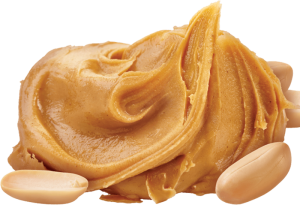
Jam packed full of calories, it has the highest number out of all the foods we’ve looked at.
- Calories per 100g – 610 kcals – 5/5
- Packaging Weight – The plastic packaging is reusable and not as heavy as the metal tins, plus it’s resealable – 4/5
- Dimension / Volume – Pretty compact – 4/5
- Shelf Life – Stored outside of the fridge you’ve only got a few months to wait before you have rancid gloop – 1/5
- Fragility – Plastic jars can easily be punctured, but it’s protected from water – 3/5
- Store Cupboard Item – Yes
Score = 17 / 25
Oats
A staple cereal for years. Definitely one to consider.
- Calories per 100g – 362 kcals – 4/5
- Packaging Weight – Minimal – 4/5
- Dimension / Volume – High volume because of all the pesky air in nature’s produce – 3/5
- Shelf Life – Will last quite a few months in the cupboard, not sure how long stuffed in the bag – 3/5
- Fragility – In just the bag its not going to be a pretty sight if it gets punctured – 2/5
- Store Cupboard Item – Yes
Score = 16 / 25
Summary
Below is a summary of the scores, starting with the best performing. The (S) denotes it’s commonly available in the store cupboard.
- Survival Biscuits – 24
- Chocolate (S) – 23
- Kendle Mint Cake – 21
- Tinned Meat (S) – 20
- Tinned Fish (S) – 19
- MRE Ration Packs – 18
- Packet Rice (S) – 18
- Preserved Meats (S) – 17
- Peanut Butter (S) – 17
- Oats (S) – 16
- Tinned Beans & Sausages (S) – 15
- Energy Bars – 12
- Low Fat Biscuits (S) – 12
And the winner is….The product designed for job!
Even if we look at the nutritional balance, the survival biscuits would still come out of top. They’re inexpensive, not something you can say about the MRE Ration Packs and they’ll sit in the bag for a descent length of time without having to change them out.
It’s great to see some of the winners are available in the store cupboard, so if you don’t want to splash out on specialist gear you’re unlikely to use everyday then there are still some great choices.
What’s Going in the Bag?
With the results in I can see I didn’t make too many bad choices, but I could have done better. Now I need to make a decision about what we’re going to put in the bag. I can either extend the number of days I can live off the contents whilst carrying the same weight, or make the most of the weight reduction we’re getting whilst keeping the calorie content the same.
This is a personal choice and one you have to make depending on which circumstances you’re preparing your bag for.
I’ve chosen a bit of each strategy, so I’ll be cutting the weight and increasing the calorie count, but not drastically.
- Oceans’ Emergency Rations – With two packs, 1kg, we’re just about getting the same amount of calories but for a third of the weight.
- Kendal Mint Cake – For variety we’re also going to add eight 85 gram bars of sweetness for a treat adding another fifty percent to the calorie count with only 680 grams of weight. I’ve chosen it over the chocolate because of its shelf life.
This means we’re packing 7,600 calories for just over half the weight of what we had in the bag before.
Is it the end of the story?
No. Depending on the situation you may have time to grab what you have in the cupboards and carry it separately to the bag, or you may be able to scavenge food whilst out in the new world and at least now you have some idea of what you should be grabbing first.
Food Gone bad?
Whatever your choice, any food can still go bad. I’ve gone for a low maintenance option which should see me only need to replace every four to five years, but when it comes to needing to use the bag you still need to use your common sense, or your nose, as your guide. If it smells or tastes bad then don’t eat it. You don’t want to be crippled with food poisoning because you ate bad food. You’re better off going hungry or using your energy to get food from the land. Keep an eye out for a future post about surviving off the land.
In the End…
What if you woke to find the electricity off, the internet down and the streets deserted? What if you were forced to run for your life, no longer top of the food chain? What if the government had no interest in keeping you alive, but you’d found a reason to struggle on, a new meaning to this life, despite those around every corner intent on hunting you down?
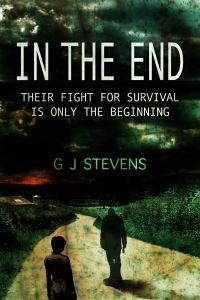
Could you survive the end of civilisation?
Meet Logan. That’s me. The first to believe the world had changed forever. The first to urge our friends to run. The first to kill, but not the first victim. I was the first to see for myself as nature bent before my eyes. With death surrounding, getting ever closer, they looked to me for answers.
This is my story.
Here’s Season One to get you started!
I always wonder where people are from? So I can imagine what influences their writing? I’ve got a bomb-shelter mentality in my kitchen……………..and now bi live above a supermarket. But without power or sunlight I would still perish. No walking dead for me in real life. Cheers,H
LikeLiked by 2 people
😁 Like my wife then. She always says she’d be the first to go! Thanks for stopping by!
LikeLiked by 1 person
I’m still packing the peanut butter and beef jerky! These are hiker heaven, weight or not. I might even dip the beef jerky in the peanut butter, then let out a wild yell.
Some items are worth their weight. 😀
LikeLiked by 2 people
Sounds yum!
LikeLiked by 1 person
great and informative post.
LikeLiked by 2 people
Thank you
LikeLiked by 1 person
An enlightening post – thank you.
LikeLiked by 2 people
Thank you
LikeLike
wow, interesting and useful information.
LikeLiked by 2 people
Thank you
LikeLiked by 1 person
GJ,
Great stuff! I am getting some of those bisquits for my next trip. I passed your site on to other campers. I hope you get some more followers.
Gary
LikeLiked by 2 people
Thank you very much!
LikeLiked by 1 person
Glad to see someone else who thinks ahead! Can’t say I agree with everything on the list, but like you said, that’s a personal choice. Personally, I’d rather starve to death than eat fish; it already smells and tastes bad. Kudos to the beef jerky though!
Being underweight as I am, food has to be a higher priority than is often recommended. I’d starve in WAY less than the average “3 weeks” other humans could survive. I’m also too little to carry enough water, so I pack a distiller to clean more as needed.
LikeLiked by 1 person
Yeah personal choice plus I don’t have all the answers. Always happy to learn!
LikeLike